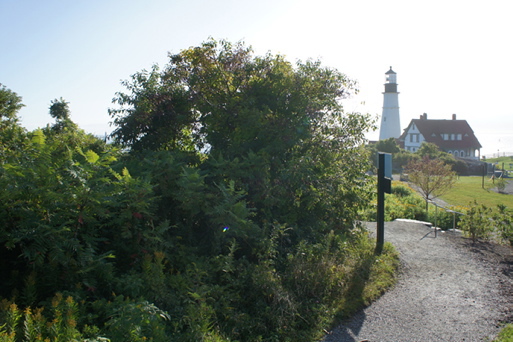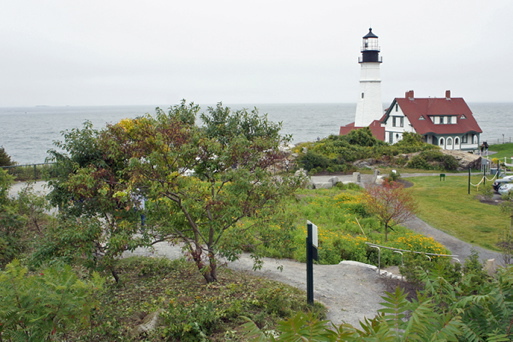Sometimes what a garden needs most is talent with strength.
The Arboretum at Fort Williams in Cape Elizabeth got that kind of help earlier this month when about 25 members of the Maine Landscape and Nursery Association volunteered for a day to remove unwanted and mostly invasive plants from the Lighthouse View Garden, the second garden to be installed at the arboretum. The arboretum has been in the planning stages since 2006; the first garden, Cliffside, was planted two years ago.
Fort Williams is a former U.S. Army fort that was purchased by the town in 1964 and turned into a park in 1979. It may have held off foreign (human) invaders in the mid-19th century, but it has been overtaken by invasive plants, including Norway maples, oriental honeysuckle, bittersweet, Japanese knotweed, multiflora roses and black swallowwort. Many of these invasives were first brought to the United States as garden ornamentals, and they proliferated when they escaped into the wild.
Half of Lighthouse View, which is located near Portland Head Light, was planted this spring, largely as a wildflower meadow with a few native shrubs, including kalmia. Earlier this month, the dominant plant was rudbeckia (black-eyed Susan), all in bright yellow bloom.
James McCain, director of the arboretum, wants the remaining part of the Lighthouse View Garden to be even more natural and to include some native plants that are already growing on the site.
A black cherry tree (Prunus serotina) was being strangled by bittersweet, but after a couple of hours of work it was standing free, properly pruned and looking good. (Full disclosure: I was among the volunteers.) Other natives freed from invasives included pin cherries (Prunus pensylvanica), arrowwood viburnum (Viburnum dentatum), smooth shadbush (Amelanchier laevis), hawthorn (Crataegus), white ash (Fraxinus americana), northern bush honeysuckle (Diervilla lonicera) and Virginia rose (rosa virginiana).
The crew also left behind some of the native staghorn sumac (Rhus typhina), but the sumac would have thrived without help. If sumac weren’t native to Maine, it would be called invasive – but a plant can’t invade its home ground. Let’s just call it aggressive.
The worst invasive plant at the Lighthouse View site is black swallowwort, is a perennial vine with lance-shaped leaves. It grows up to 6 feet tall, wrapping around other plants and killing them. Its botanical name is Cynanchum Louiseae, and Cynanchum translates to dog strangler, which leads to its other common name, the dog-strangling vine. Swallowwort is also related to milkweed and has pods with many seeds that look like milkweed pods. When monarch butterflies mistakenly lay their eggs on swallowwort, the larvae can’t eat it and die. The volunteer day was timed in part to remove the swallowwort pods before they could disperse their seeds; only a few of the pods had opened before the day of the project.
McCain said the arboretum has received a grant to buy some additional plants for the Lighthouse View Garden for the 2016 growing season, when he hopes to have the invasives under control. Controlling the invasives will require more volunteer time, and perhaps more extreme methods. In the Cliffside garden, most of the soil was removed before the garden was planted. (It still requires regular weeding by an intern, a horticulture student at Southern Maine Community College.) Once removed, the swallowwort is usually put in bags and sent to Regional Waste Systems to be incinerated. In this case, because the invasives we pulled got mixed together, we covered the pile with a tarp, to prevent the seeds from escaping, and left them to die. (Home gardeners should put invasives in the trash, and not in their compost.)
The next major project at the arboretum, perhaps as early as next year, will be the Children’s Garden, which will be located behind the tennis courts and lily-pad pond in the park.
“This isn’t going to be a children’s garden like the one at Coastal Maine Botanical Gardens in Boothbay,” McCain said. (That garden has a pond, boats, windmills and playhouses, plus a theme based on Maine’s children’s books.) “It’s more of a place where children can play in a natural environment.”
Once the invasive plants – including some huge Norway maples – are removed, a meadow will be planted at the top of a hillside above the pond. A maze will be cut into the meadow for younger children. Water from the existing pond will be pumped uphill to create a stream where children can play. Areas have also been set aside for tree forts and fairy houses.
The Children’s Garden will incorporate an existing feature there: A stone circle, about 3 feet high and 20 feet in diameter, with a stone floor. That structure is being renamed a council ring, and repaired, with a new stone floor. The ring will double as the entrance to the children’s garden and as a place to gather. To raise money to pay for the Children’s Garden, the arboretum is selling engraved stone pavers that will be used as part of the council ring floor. Prices range from $350 for a 4- by 8-inch paver up to $10,000 for a larger stone that is part of the circle center. For information go to fortwilliams.org, hit the link for projects, then Children’s Garden.
Send questions/comments to the editors.




Success. Please wait for the page to reload. If the page does not reload within 5 seconds, please refresh the page.
Enter your email and password to access comments.
Hi, to comment on stories you must . This profile is in addition to your subscription and website login.
Already have a commenting profile? .
Invalid username/password.
Please check your email to confirm and complete your registration.
Only subscribers are eligible to post comments. Please subscribe or login first for digital access. Here’s why.
Use the form below to reset your password. When you've submitted your account email, we will send an email with a reset code.